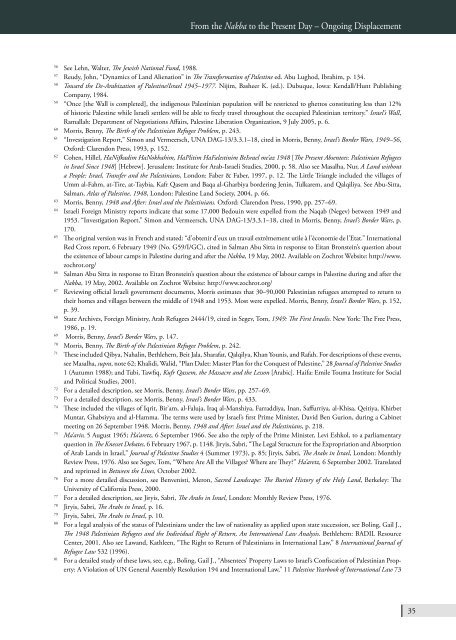BADIL Resource Center for Palestinian Residency and Refugee
BADIL Resource Center for Palestinian Residency and Refugee
BADIL Resource Center for Palestinian Residency and Refugee
Create successful ePaper yourself
Turn your PDF publications into a flip-book with our unique Google optimized e-Paper software.
From the Nakba to the Present Day – Ongoing Displacement<br />
56 See Lehn, Walter, The Jewish National Fund, 1988.<br />
57 Reudy, John, “Dynamics of L<strong>and</strong> Alienation” in The Trans<strong>for</strong>mation of Palestine ed. Abu Lughod, Ibrahim, p. 134.<br />
58 Toward the De-Arabization of Palestine/Israel 1945–1977. Nijim, Basheer K. (ed.). Dubuque, Iowa: Kendall/Hunt Publishing<br />
Company, 1984.<br />
59 “Once [the Wall is completed], the indigenous <strong>Palestinian</strong> population will be restricted to ghettos constituting less than 12%<br />
of historic Palestine while Israeli settlers will be able to freely travel throughout the occupied <strong>Palestinian</strong> territory.” Israel’s Wall,<br />
Ramallah: Department of Negotiations Affairs, Palestine Liberation Organization, 9 July 2005, p. 6.<br />
60 Morris, Benny, The Birth of the <strong>Palestinian</strong> <strong>Refugee</strong> Problem, p. 243.<br />
61 “Investigation Report,” Simon <strong>and</strong> Vermeersch, UNA DAG-13/3.3.1–18, cited in Morris, Benny, Israel’s Border Wars, 1949–56,<br />
Ox<strong>for</strong>d: Clarendon Press, 1993, p. 152.<br />
62 Cohen, Hillel, HaNifkadim HaNokhahim, HaPlitim HaFalestinim BeIsrael me’az 1948 [The Present Absentees: <strong>Palestinian</strong> <strong>Refugee</strong>s<br />
in Israel Since 1948] [Hebrew]. Jerusalem: Institute <strong>for</strong> Arab-Israeli Studies, 2000, p. 58. Also see Masalha, Nur, A L<strong>and</strong> without<br />
a People: Israel, Transfer <strong>and</strong> the <strong>Palestinian</strong>s, London: Faber & Faber, 1997, p. 12. The Little Triangle included the villages of<br />
Umm al-Fahm, at-Tire, at-Taybia, Kafr Qasem <strong>and</strong> Baqa al-Gharbiya bordering Jenin, Tulkarem, <strong>and</strong> Qalqiliya. See Abu-Sitta,<br />
Salman, Atlas of Palestine, 1948, London: Palestine L<strong>and</strong> Society, 2004, p. 66.<br />
63 Morris, Benny, 1948 <strong>and</strong> After: Israel <strong>and</strong> the <strong>Palestinian</strong>s. Ox<strong>for</strong>d: Clarendon Press, 1990, pp. 257–69.<br />
64 Israeli Foreign Ministry reports indicate that some 17,000 Bedouin were expelled from the Naqab (Negev) between 1949 <strong>and</strong><br />
1953. “Investigation Report,” Simon <strong>and</strong> Vermeersch, UNA DAG-13/3.3.1–18, cited in Morris, Benny, Israel’s Border Wars, p.<br />
170.<br />
65 The original version was in French <strong>and</strong> stated: “d’obtenir d’eux un travail extrêmement utile à l’èconomie de l’Etat.” International<br />
Red Cross report, 6 February 1949 (No. G59/I/GC), cited in Salman Abu Sitta in response to Eitan Bronstein’s question about<br />
the existence of labour camps in Palestine during <strong>and</strong> after the Nakba, 19 May, 2002. Available on Zochrot Website: http://www.<br />
zochrot.org/<br />
66 Salman Abu Sitta in response to Eitan Bronstein’s question about the existence of labour camps in Palestine during <strong>and</strong> after the<br />
Nakba, 19 May, 2002. Available on Zochrot Website: http://www.zochrot.org/<br />
67 Reviewing official Israeli government documents, Morris estimates that 30–90,000 <strong>Palestinian</strong> refugees attempted to return to<br />
their homes <strong>and</strong> villages between the middle of 1948 <strong>and</strong> 1953. Most were expelled. Morris, Benny, Israel’s Border Wars, p. 152,<br />
p. 39.<br />
68 State Archives, Foreign Ministry, Arab <strong>Refugee</strong>s 2444/19, cited in Segev, Tom, 1949: The First Israelis. New York: The Free Press,<br />
1986, p. 19.<br />
69 Morris, Benny, Israel’s Border Wars, p. 147.<br />
70 Morris, Benny, The Birth of the <strong>Palestinian</strong> <strong>Refugee</strong> Problem, p. 242.<br />
71 These included Qibya, Nahalin, Bethlehem, Beit Jala, Sharafat, Qalqilya, Khan Younis, <strong>and</strong> Rafah. For descriptions of these events,<br />
see Masalha, supra, note 62; Khalidi, Walid, “Plan Dalet: Master Plan <strong>for</strong> the Conquest of Palestine,” 28 Journal of Palestine Studies<br />
1 (Autumn 1988); <strong>and</strong> Tubi, Tawfiq, Kufr Qassem, the Massacre <strong>and</strong> the Lesson [Arabic]. Haifa: Emile Touma Institute <strong>for</strong> Social<br />
<strong>and</strong> Political Studies, 2001.<br />
72 For a detailed description, see Morris, Benny, Israel’s Border Wars, pp. 257–69.<br />
73 For a detailed description, see Morris, Benny, Israel’s Border Wars, p. 433.<br />
74 These included the villages of Iqrit, Bir’am, al-Faluja, Iraq al-Manshiya, Farraddiya, Inan, Saffurriya, al-Khisa, Qeitiya, Khirbet<br />
Muntar, Ghabsiyya <strong>and</strong> al-Hamma. The terms were used by Israel’s first Prime Minister, David Ben Gurion, during a Cabinet<br />
meeting on 26 September 1948. Morris, Benny, 1948 <strong>and</strong> After: Israel <strong>and</strong> the <strong>Palestinian</strong>s, p. 218.<br />
75 Ma’ariv, 5 August 1965; Ha’aretz, 6 September 1966. See also the reply of the Prime Minister, Levi Eshkol, to a parliamentary<br />
question in The Knesset Debates, 6 February 1967, p. 1148. Jiryis, Sabri, “The Legal Structure <strong>for</strong> the Expropriation <strong>and</strong> Absorption<br />
of Arab L<strong>and</strong>s in Israel,” Journal of Palestine Studies 4 (Summer 1973), p. 85; Jiryis, Sabri, The Arabs in Israel, London: Monthly<br />
Review Press, 1976. Also see Segev, Tom, “Where Are All the Villages? Where are They?” Ha’aretz, 6 September 2002. Translated<br />
<strong>and</strong> reprinted in Between the Lines, October 2002.<br />
76 For a more detailed discussion, see Benvenisti, Meron, Sacred L<strong>and</strong>scape: The Buried History of the Holy L<strong>and</strong>, Berkeley: The<br />
University of Cali<strong>for</strong>nia Press, 2000.<br />
77 For a detailed description, see Jiryis, Sabri, The Arabs in Israel, London: Monthly Review Press, 1976.<br />
78 Jiryis, Sabri, The Arabs in Israel, p. 16.<br />
79 Jiryis, Sabri, The Arabs in Israel, p. 10.<br />
80 For a legal analysis of the status of <strong>Palestinian</strong>s under the law of nationality as applied upon state succession, see Boling, Gail J.,<br />
The 1948 <strong>Palestinian</strong> <strong>Refugee</strong>s <strong>and</strong> the Individual Right of Return, An International Law Analysis. Bethlehem: <strong>BADIL</strong> <strong>Resource</strong><br />
<strong>Center</strong>, 2001. Also see Law<strong>and</strong>, Kathleen, “The Right to Return of <strong>Palestinian</strong>s in International Law,” 8 International Journal of<br />
<strong>Refugee</strong> Law 532 (1996).<br />
81 For a detailed study of these laws, see, e.g., Boling, Gail J., “Absentees’ Property Laws to Israel’s Confiscation of <strong>Palestinian</strong> Property:<br />
A Violation of UN General Assembly Resolution 194 <strong>and</strong> International Law,” 11 Palestine Yearbook of International Law 73<br />
35

















